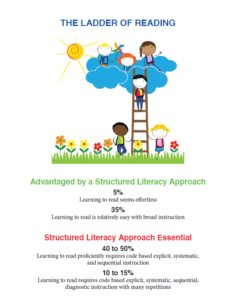So, What Is Structured Literacy?
In the 1920s, Dr. Samuel T. Orton and Anna Gillingham created a method that was phonics-based, systematic, explicit, highly structured, and multi-sensory to help students with dyslexia — known as the Orton-Gillingham method. Over time educators and academic researchers built upon this method to develop what we know today as Structured Literacy™.
Structured Literacy supports explicit, sequential, systematic, prescriptive, diagnostic, and cumulative instruction to benefit all learners, both general education and remedial. Through the IMSE Impact Structured Literacy programs, IMSE-trained educators can implement appropriate literacy instruction for all students that can especially benefit students with learning differences.
Comprehension is the ultimate goal of reading, driven by two broad skill sets identified in the Simple View of Reading as word recognition and language comprehension. The Science of Reading identifies five essential components that make up the Simple View of Reading: phonemic awareness, phonics, fluency, vocabulary, and comprehension. Structured Literacy incorporates all five.
The Science of Reading has proven that a Structured Literacy approach is a necessary foundation for reading success.
Structured Literacy emphasizes the structure of language through:
- Phonology – Speech sounds
- Sound-Symbol Association – The relationship between sounds and symbols
- Syllables – A word or part of a word that contains one vowel phoneme
- Morphology – The study of the forms of words
- Syntax – Sentence structure
- Semantics – Meaning of words
How the elements of Structured Literacy are taught:
- Systematic – The delivery of instruction follows a well-defined scope and sequence, which provides a logical progression of skills that move from simple to more complex.
- Cumulative – Newly introduced concepts are layered upon previously learned concepts. The foundation of knowledge for phoneme-grapheme relationships, reliable spelling patterns, and generalization of rules is frequently reviewed to build automaticity.
- Explicit – The teacher gives a direct and clear explanation for each new concept during explicit instruction. Instruction should be enhanced with multi-sensory strategies to involve the visual, auditory, and tactile/kinesthetic senses in learning to improve memory.
- Diagnostic – Continuous formative assessment informs progress monitoring and allows teachers to measure outcomes and make decisions for prescriptive teaching and differentiation.
The Ladder of Reading
Up to 50 percent of children require direct, or explicit, instruction to learn to read proficiently, while up to 15 percent of children need explicit instruction to learn to read. Each sound and symbol is taught in isolation (as a discrete unit) until children can manipulate the sounds and symbols to create words and sentences independently.

Adapted from: Young, N., Lyon, IDA, & Hempenstall. (2017). Structured Reading Infographic: Ladder of Reading. Retrieved August 01, 2018, from https://dyslexiaida.org/ladder-of-reading-infographic-structured-literacyhelps- all-students/
Some children learn to read regardless of the type of reading instruction received. Approximately 40 percent of children learn to read relatively easily with broad, or implicit, instruction. These students can recognize patterns and words as a whole. However, all children still benefit from explicit instruction to reach their maximum reading potential.
Be sure to check out the rest of our blog series on Structured Literacy vs. Balanced Literacy:
- What Is Balanced Literacy? Part 2 of Structured Literacy vs. Balanced Literacy
- Why Teach Structured Literacy Part 3 of Structured Literacy vs. Balanced Literacy
- How to Teach Structured Literacy Part 4 of Structured Literacy vs. Balanced Literacy
IMSE believes that all children should be able to read. To achieve this end, IMSE wants to bring Structured Literacy and Orton-Gillingham to all educators to give children the best literacy instruction possible.
Learn more about what you can do to improve literacy for all using the Institute for Multi-Sensory Education’s Structured Literacy training.
Please connect with us on Facebook, Twitter, Instagram, LinkedIn, and Pinterest to get tips and tricks from your peers and us. Read the IMSE Journal to hear success stories from other schools and districts, and be sure to read the OG Weekly email series for refreshers and tips.
